Precision Targeting of Innovators and Early Adopters for Quantitative Future Insights
Toru Yamashita, Head of Future Insights
We have successfully categorized people from innovators to laggards, as described in the Diffusion of Innovation Theory (Rogers, 1962), by our unique approach. We will introduce how to approach visionary innovators and early adopters for obtaining future insights, quantitatively.
First, we will explain how we defined the five types of segments from innovators to laggards. Then we will explain what characteristics those classified innovators and early adopters have.
Defining the segments
Over the years, we may have identified innovators as people who say they purchase new products earlier than others. However, this is extremely subjective and causes discrepancies with the actual situation. In our approach, we focused on categorizing people based on their behavior: upon when they purchased a specific product/service or when it was first used.
The process of defining was done through the following steps: (1) setting the areas of products/services, (2) survey for categorization, and (3) establishing the definition. In the first step, more than 100 products/services currently in use were listed. Then we narrowed them down to 32 categories, and finally to 10 areas.
■The 10 areas of products/services
- ESG/SDGs
- Healthcare
- Tech
- Gadgets
- Money
- Food
- Travel
- Entertainment
- Business
- Communication

The survey asked the respondents about the 32 products/services when they started using them. To those who said they started using the product this year, 1 point was given. If it was last year, 2 points were given. Another 1 point would be added dating back one more year ago, and so on. A maximum of 12 points were given, depending on their answer. Those who said they had no plans to use it or did not know about it received 0 points.
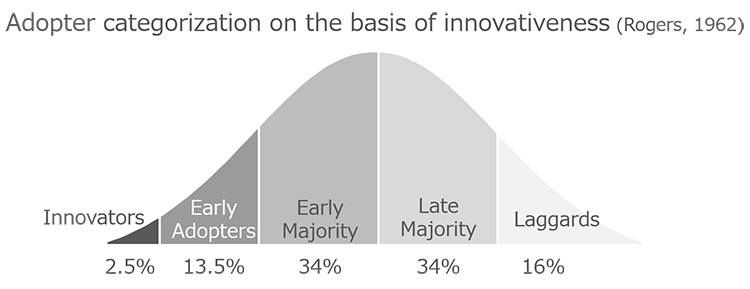
Respondents' scores were calculated in each of the 10 product/service areas, and following the definition in the Diffusion of Innovation Theory, the top 2.5% were identified as innovators, while the next 16% were identified as early adopters. A person will not be categorized as an innovator if he or she started using just one product/service early, but rather if they have started using it early in multiple areas of products/services.
The Diffusion of Innovation Theory is based on the assumption that the state of diffusion is close to a normal distribution.
In our study, categorization was possible in the areas of ESG/SDGs, healthcare, tech, gadgets, and money. However, the other half; food, travel, entertainment, business, and communication, did not have a normal distribution of scores but rather a power distribution resulting in the categorization to be not efficient to apply. It is not clear whether these areas are not suitable for applying the theory, or whether it was not appropriate at a more granular level (products/services). This shall be a future issue to be examined with different products/services.
Characteristics of innovators and early adopters
We conducted an online survey approaching NIKKEI subscribers to explore the characteristics of each segment. Our access to NIKKEI subscribers allows us to approach high-profile business professionals in Japan.
Read more about our unique audience resource below.
Nikkei ID Research Service -- Approaching to the hard-to-reach audiences
■Outline of the survey
| Method | Online survey |
|---|---|
| Target area | Japan |
| Target audience | 18-65 years old, business professionals |
| Number of respondents | 2,065 completes |
| Timing | April–May 2022 |
Demographics
Innovators have more portion of the 30s and 40s than other types. In early adopters, 50s are the majority but the 40s, 30s, and 20s are also relatively large.
Innovators consist of many section managers and corporate board members. On the other hand, section chiefs were the most common among early adopters. Innovators and early adopters have fewer general and contract employees than other types of employees.
Innovators have by far the highest annual income of 20 million yen or more compared to the other types. Early adopters and the early majority have the highest amount of 10–20 million yen, but a closer look reveals a higher segment of early adopters, 15–20 million yen. On the other hand, the volume zone for the early majority is slightly lower, at 10–15 million yen.
■Characteristics of each type
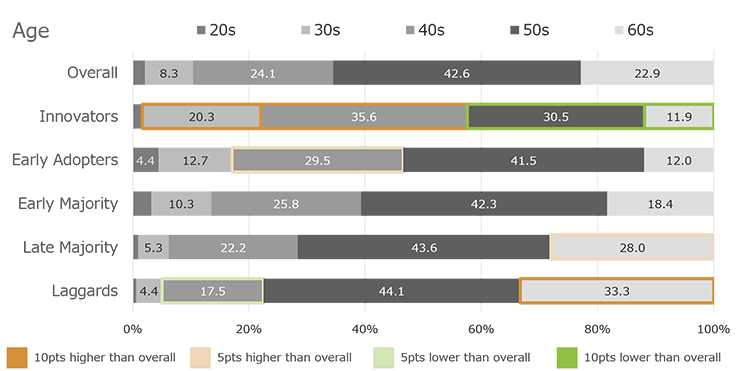
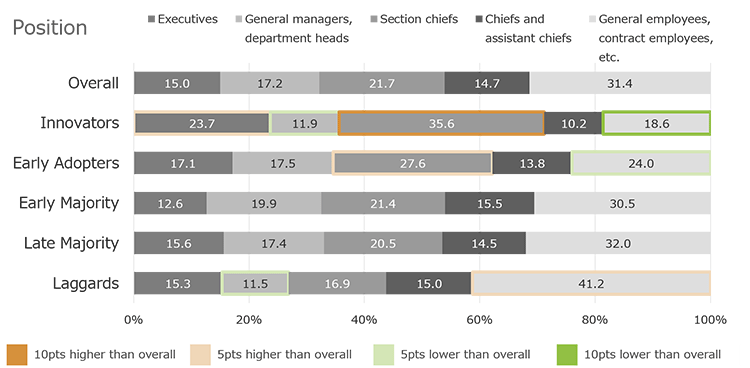
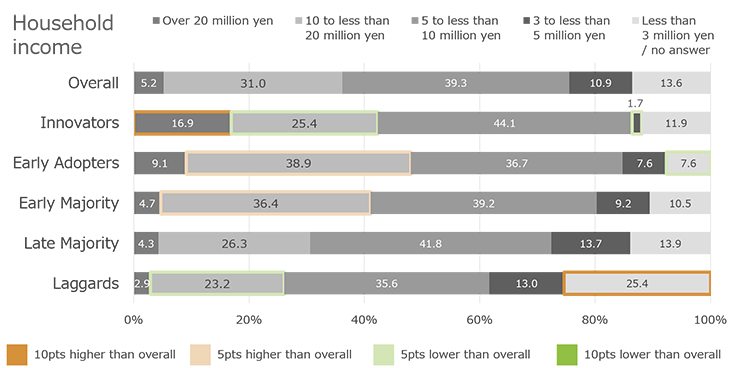
Product design
The survey asked questions about product design based on CVPA (Centrality of Visual Product Aesthetics), a scale consisting of three dimensions: value, acumen, and response. Value is the degree to which users are satisfied or delighted by a good design. Acumen is the degree to which users pay attention to design features. Response is the degree to which people desire a product with a good design. A total of 11 questions were asked as related items to these three dimensions.
■Items of CVPA measurement (Bloch et al., 2003)
| Value | |
|---|---|
| 1 | Owning products that have superior designs makes me feel good about myself. |
| 2 | I enjoy seeing displays of products that have superior designs. |
| 3 | A product’s design is a source of pleasure for me. |
| 4 | Beautiful product designs make our world a better place to live. |
| Acumen | |
| 5 | Being able to see subtle differences in product designs is one skill that I have developed over time. |
| 6 | I see things in a product’s design that other people tend to pass over. |
| 7 | I have the ability to imagine how a product will fit in with designs of other things I already own. |
| 8 | I have a pretty good idea of what makes one product look better than its competitors. |
| Response | |
| 9 | Sometimes the way a product looks seems to reach out and grab me. |
| 10 | If a product’s design really "speaks" to me, I feel that I must buy it. |
| 11 | When I see a product that has a really great design, I feel a strong urge to buy it. |
■Innovators and early adopters show high intentions in the CVPA measurement
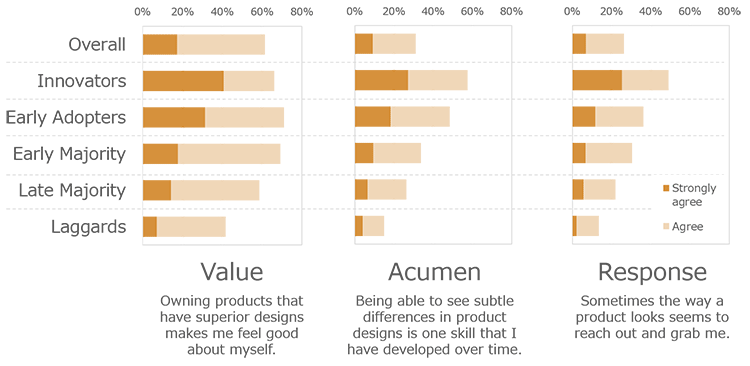
The results of CVPA measurement indicate that innovators and early adopters not only value good design but also pay more attention to design and have a stronger desire for well-designed products.
Innovators are those in their 30s~40s who are financially stable and at the forefront of business. Slightly older, but similar to early adopters. Both are financially stable and in reasonable positions. In addition, they are very much obsessed with design. However, the innovators are slightly younger and have a higher profile, higher incomes, and greater consciousness to design.
How innovators and early adopters perceive brands
We asked innovators and early adopters of tech products/services "What makes each brand superior?" with the option of five factors: quantitative functions/specs, design, safety/durability, price, and management/business model. Comparing three of the brands measured, Sony, Panasonic, and Apple, Sony and Apple scored high in design, while Panasonic had the top score in safety/durability. These three brands also scored higher than the overall score for a superior price.
On the other hand, quantitative functions/specs may not be very satisfactory among innovators and early adopters, with all brands scoring lower than overall. It may be described as although the price is excellent, functionality and performance are not rated very highly. In other words, they are becoming commoditized.
■Brand perceptions by innovators and early adopters
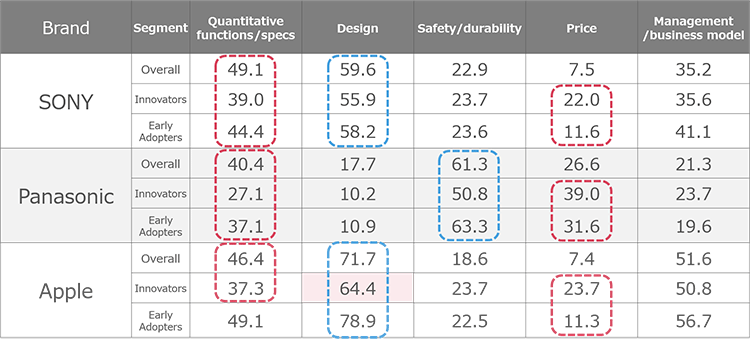
Innovators and early adopters are those who are very conscious of product design. Looking at Apple, there is a significant share, over one-third, of the innovators who do not feel Apple's design is superb. By contrast, for example, one of the brands which innovators do appreciate for its design was Tesla. With 54.2% of innovators saying the design is excellent, nearly 20 points higher than the overall at 36.3%.
Future insights by focusing on the leading segments
Companies have seeds of technologies. However, it is necessary to evaluate them from the user's perspective, such as whether users will accept those seeds, or how they will make use of them. While it is not enough to ask such questions to just anyone but the opinions of innovators and early adopters are much more important for future insight. Our identification and approach to innovators and early adopters, the segments we should turn more attention to, suggest the possibility to gain a more accurate insight into the future.
please contact us below.
